
A maggot is the larva of a fly ; it is applied in particular to the larvae of Brachycera flies, such as houseflies, cheese flies, and blowflies, rather than larvae of the Nematocera, such as mosquitoes and Crane flies. A 2012 study estimated the population of maggots in North America alone to be in excess of 3×1017.

The Calliphoridae are a family of insects in the order Diptera, with 1,200 known species. The maggot larvae, often used as fishing bait, are known as gentles. The family is known to be polyphyletic, but much remains disputed regarding proper treatment of the constituent taxa, some of which are occasionally accorded family status.
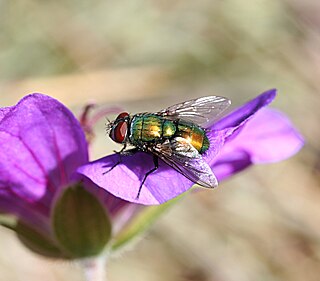
The common green bottle fly is a blowfly found in most areas of the world and is the most well-known of the numerous green bottle fly species. Its body is 10–14 millimetres (0.39–0.55 in) in length – slightly larger than a house fly – and has brilliant, metallic, blue-green or golden coloration with black markings. It has short, sparse black bristles (setae) and three cross-grooves on the thorax. The wings are clear with light brown veins, and the legs and antennae are black. The larvae of the fly may be used for maggot therapy, are commonly used in forensic entomology, and can be the cause of myiasis in livestock and pets.
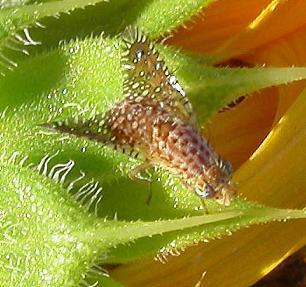
Paracantha is a genus of fruit flies in the family Tephritidae. There are about 10 described species in Paracantha.

Calliphora vomitoria, known as the blue bottle fly, orange-bearded blue bottle, or bottlebee is a species of blow fly, a species in the family Calliphoridae. Calliphora vomitoria is the type species of the genus Calliphora. It is common throughout many continents including Europe, Americas, and Africa. They are fairly large flies, nearly twice the size of the housefly. They can be easily identified by their shiny, blue bodies.

The species Phormia regina , more commonly known as the black blow fly, belongs to the blow fly family Calliphoridae and was first described by Johann Wilhelm Meigen.
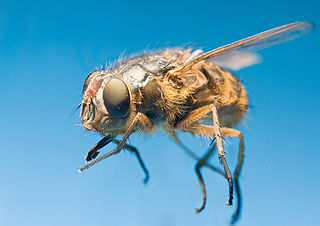
The Calliphorinae are a subfamily of the blow fly family Calliphoridae. The distinguishing characteristics of this subfamily are: the stem vein is bare, the lower calypter and the proepisternal depression are bristly, but the suprasquamal region is bare or with only a few random bristles. The thorax is dull and bears fine hairs, and the abdomen is usually colored shining blue.
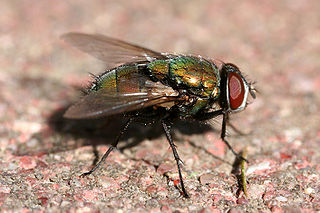
The Luciliinae are a subfamily of Calliphoridae, or blow flies. According to Whitworth, the distinguishing characteristics of this subfamily are its shining green, blue, or bronze thorax and abdomen, suprasquamal ridge with a setae cluster, and a bare lower calypter. When measuring the head to frons ratios in females, the frons is not narrowest at the vertex as in most of the female Calliphoridae. This subfamily includes one genus: Lucilia.
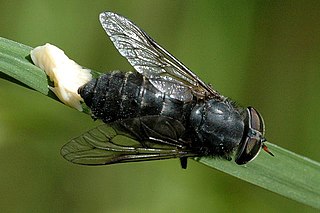
Hybomitra is a genus of horse flies in the family Tabanidae. There are at least 240 described species in Hybomitra.

The common toad fly, Lucilia silvarum, is a member of the fly family Calliphoridae. This fly was first discovered by Johann Wilhelm Meigen in 1826 and is found most notably in European and Western Countries.
Lucilia thatuna belongs to the family Calliphoridae, the species most commonly referred to as the blowflies, and the genus Lucilia. Along with several other species of Lucilia, L. thatuna is commonly referred to as a green bottle fly. L. thatuna is very scarce and not much is known about this particular fly. It has been noted to reside in mountainous regions of the northwestern United States.

The species Lucilia cuprina, formerly named Phaenicia cuprina, is more commonly known as the Australian sheep blowfly.
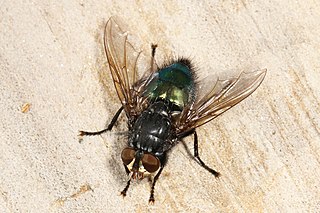
Cynomya cadaverina, also known as the shiny blue bottle fly, is a member of the family Calliphoridae, which includes blow flies as well as bottle flies. In recent years, this family has become a forensically important facet in many medicocriminal investigations in the growing field of forensic entomology. C. cadaverina is specifically important in determining a post-mortem interval, as well as other important factors.

Lucilia mexicana is a species of blow fly of the family Calliphoridae, one of many species known as a green bottle fly. Its habitat range extends from southwestern North America to Brazil. L. mexicana is typically 6–9 mm in length with metallic blue-green coloring. This species is very similar in appearance to L. coeruleiviridis, the primary difference being that L. mexicana has two or more complete rows of post-ocular setae. L. mexicana has the potential to be forensically important in the stored-products and medicocriminal fields, but more research is needed for the fly to be used as evidence in criminal investigations.

Calliphora livida is a member of the family Calliphoridae, the blow flies. This large family includes the genus Calliphora, the "blue bottle flies". This genus is important in the field of forensic entomology because of its value in post-mortem interval estimation.

Lucilia coeruleiviridis, formerly Phaenecia coeruleiviridis, is commonly known as a green bottle fly, because of its metallic blue-green thorax and abdomen. L. coeruleiviridis was first discovered by French entomologist Pierre-Justin-Marie Macquart in 1855. It belongs to the family Calliphoridae and is one of many forensically important Diptera, as it is often found on decaying substances. L. coeruleiviridis is one of the most ubiquitous blow fly species in the southeastern United States, particularly in the spring and fall months.

Lucilia caesar is a member of the fly family Calliphoridae commonly known as blow flies. L. caesar is commonly referred to as the common greenbottle. The adult flies typically feed on pollen and nectar of flowers. The larvae feed mainly on carrion.

Lepidodexia is a genus of flesh flies in the family Sarcophagidae. There are at least 170 described species in Lepidodexia.

Lucilia cluvia is a species of blow fly in the family Calliphoridae.

Minettia fasciata is a species of fly in the family Lauxaniidae.


















